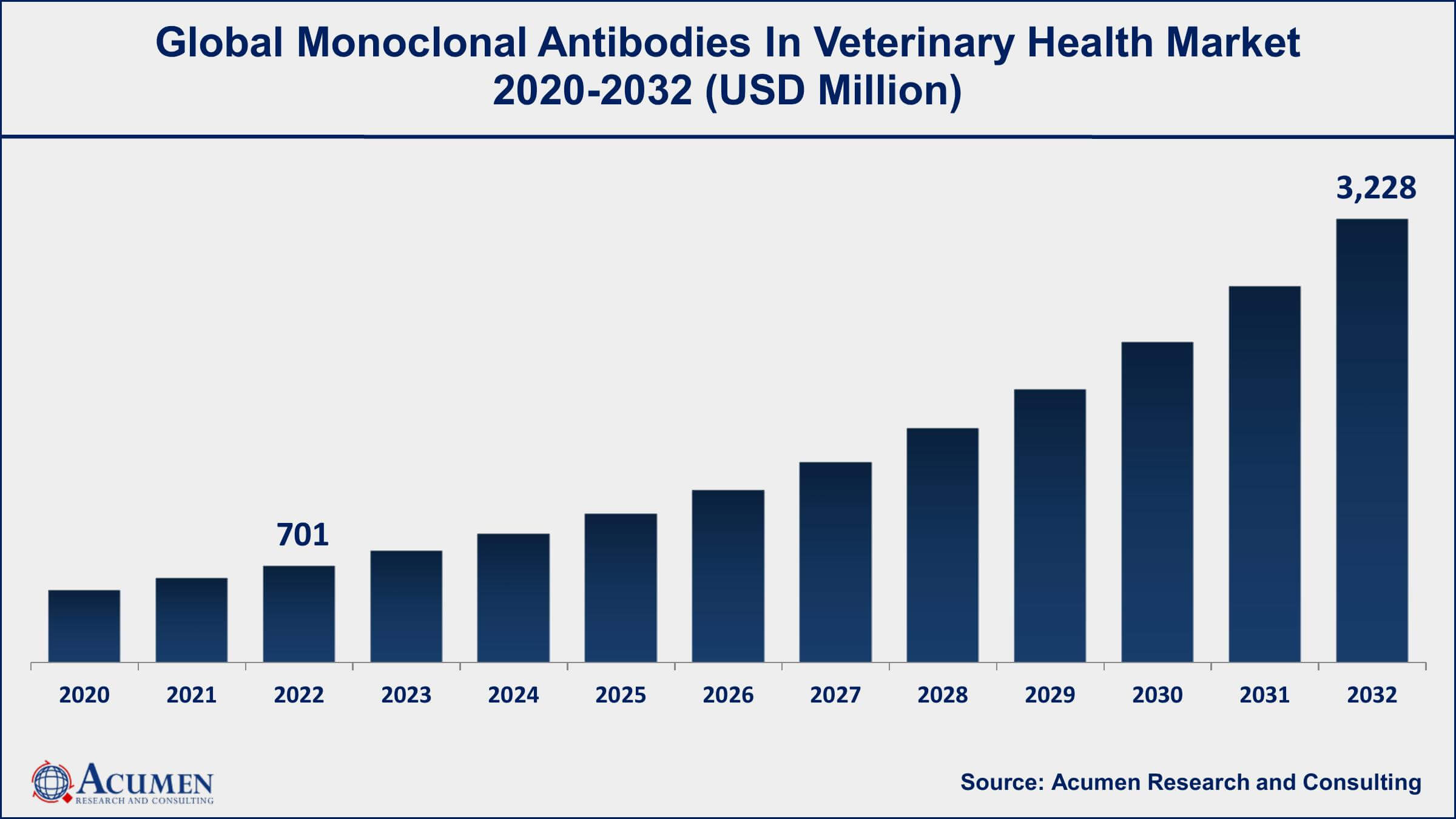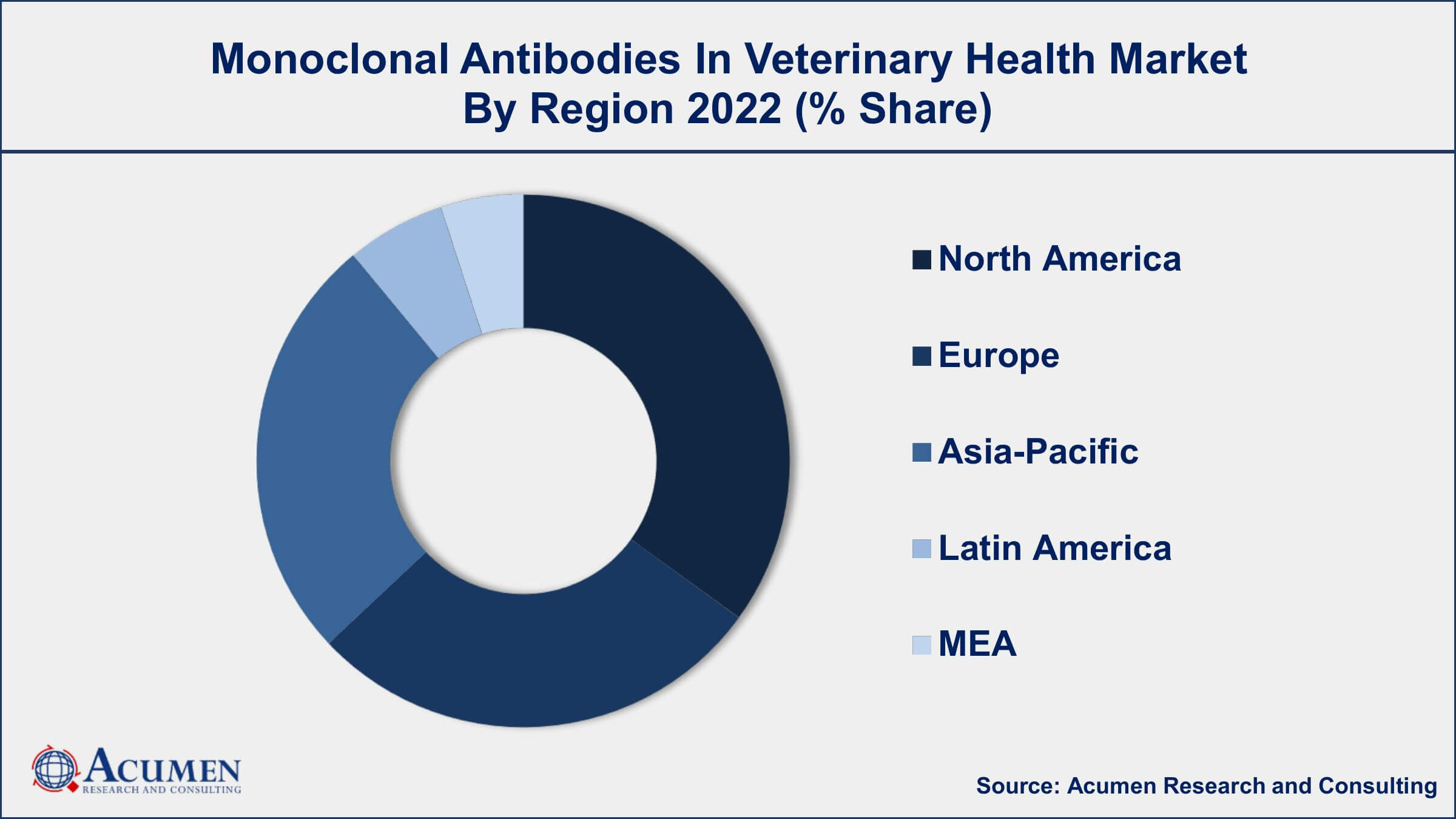Monoclonal Antibodies In Veterinary Health Market | Acumen Research and Consulting
Monoclonal Antibodies in Veterinary Health Market Size - Global Industry, Share, Analysis, Trends and Forecast 2023 - 2032
Published :
Report ID:
Pages :
Format :
The Global Monoclonal Antibodies in Veterinary Health Market Size accounted for USD 701 Million in 2022 and is projected to achieve a market size of USD 3,228 Million by 2032 growing at a CAGR of 16.6% from 2023 to 2032.
Monoclonal Antibodies in Veterinary Health Market Highlights
- Global Monoclonal Antibodies in Veterinary Health Market revenue is expected to increase by USD 3,228 Million by 2032, with a 16.6% CAGR from 2023 to 2032
- North America region led with more than 39% of Monoclonal Antibodies in Veterinary Health Market share in 2022
- Asia-Pacific Monoclonal Antibodies in Veterinary Health Market growth will record a CAGR of more than 17.3% from 2023 to 2032
- By animal type, the companion animals segment has recorded more than 69% of the revenue share in 2022
- By application, the dermatology segment has accounted more than 49% of the revenue share in 2022
- Increasing demand for advanced veterinary healthcare, drives the Monoclonal Antibodies in Veterinary Health Market Value

Monoclonal antibodies (mAbs) in veterinary health refer to a class of biologic drugs designed to target specific antigens or markers on cells or pathogens in animals. These antibodies are produced in the laboratory, derived from a single type of immune cell, and engineered to bind to a particular target with high specificity. Once administered to animals, mAbs can have various therapeutic applications, including treating infectious diseases, autoimmune disorders, and certain types of cancers. They work by either directly neutralizing pathogens or modulating the immune response to aid in the management of various health conditions in animals.
The market for monoclonal antibodies in veterinary health has shown significant growth in recent years. As advancements in biotechnology and veterinary medicine continue, there is an increasing demand for effective and targeted treatment options for animals. With the rising awareness among pet owners and livestock producers about the potential benefits of mAbs, there has been a growing interest in their usage. Veterinary pharmaceutical companies and biotech firms are investing in research and development efforts to create novel mAbs that address specific health challenges in companion animals and livestock. Moreover, as regulatory bodies approve more mAbs for veterinary use, the market is expected to expand further, with a broader range of indications and applications.

Global Monoclonal Antibodies in Veterinary Health Market Trends
Market Drivers
- Increasing demand for advanced veterinary healthcare
- Advancements in biotechnology and research
- Rising prevalence of chronic and infectious diseases in animals
- Growing pet ownership and human-animal bond
Market Restraints
- High cost of monoclonal antibody therapies
- Limited range of approved products
Market Opportunities
- Customization and personalization of therapies
- Expansion of the companion animal market
Monoclonal Antibodies in Veterinary Health Market Report Coverage
| Market | Monoclonal Antibodies in Veterinary Health Market |
| Monoclonal Antibodies in Veterinary Health Market Size 2022 | USD 701 Million |
| Monoclonal Antibodies in Veterinary Health Market Forecast 2032 | USD 3,228 Million |
| Monoclonal Antibodies in Veterinary Health Market CAGR During 2023 - 2032 | 16.6% |
| Monoclonal Antibodies in Veterinary Health Market Analysis Period | 2020 - 2032 |
| Monoclonal Antibodies in Veterinary Health Market Base Year | 2022 |
| Monoclonal Antibodies in Veterinary Health Market Forecast Data | 2023 - 2032 |
| Segments Covered | By Animal Type, By Application, By End-user, And By Geography |
| Regional Scope | North America, Europe, Asia Pacific, Latin America, and Middle East & Africa |
| Key Companies Profiled | Zoetis, Elanco Animal Health, Boehringer Ingelheim Animal Health, Merck Animal Health, Bayer Animal Health, Vetoquinol, Virbac, IDEXX Laboratories, Dechra Pharmaceuticals, Heska Corporation, and Kindred Biosciences. |
| Report Coverage |
Market Trends, Drivers, Restraints, Competitive Analysis, Player Profiling, Covid-19 Analysis, Regulation Analysis |
Monoclonal antibodies (mAbs) in veterinary health are a class of biologic drugs designed to target specific antigens or markers on cells or pathogens in animals. These antibodies are produced in the laboratory through genetic engineering techniques, originating from a single type of immune cell. They are designed to bind to a particular target with high specificity, making them effective therapeutic agents for various health conditions in animals. Once administered, monoclonal antibodies can have diverse applications in veterinary medicine, including treating infectious diseases, autoimmune disorders, and certain types of cancers. They work by either directly neutralizing pathogens, such as viruses or bacteria, or by modulating the immune response to aid in the management of chronic conditions in animals.
The applications of monoclonal antibodies in veterinary health are wide-ranging. In companion animals, they can be used to treat various infectious diseases, such as parvovirus in dogs or feline leukemia virus in cats. Additionally, mAbs have shown promise in managing chronic inflammatory conditions like atopic dermatitis in dogs or autoimmune disorders in cats. In the livestock sector, monoclonal antibodies are utilized to control and prevent infectious diseases that can have significant economic impacts, such as bovine respiratory disease or swine dysentery.
The monoclonal antibodies (mAbs) in veterinary health market is experiencing steady growth, driven by various factors. The increasing awareness of pet owners and livestock producers about the potential benefits of mAbs has led to a rising demand for these targeted therapies in animals. Advancements in biotechnology and veterinary medicine have enabled the development of more effective and specific mAbs for various health conditions in companion animals and livestock. Moreover, the growing human-animal bond and the rising importance of animal health have further bolstered the demand for advanced treatment options, including mAbs, to improve the well-being of animals.
Monoclonal Antibodies in Veterinary Health Market Segmentation
The global Monoclonal Antibodies in Veterinary Health Market segmentation is based on animal type, application, end-user, and geography.
Monoclonal Antibodies in Veterinary Health Market By Animal Type
- Companion Animals
- Livestock
According to the monoclonal antibodies in veterinary health industry analysis, the companion animals segment accounted for the largest market share in 2022. There has been a notable increase in pet ownership worldwide, with more people considering companion animals as part of their families. This growing human-animal bond has heightened the demand for advanced and targeted therapies, including mAbs, to improve the health and well-being of companion animals. The development and availability of specific monoclonal antibodies for various health conditions commonly affecting companion animals have played a crucial role in driving market growth.
Monoclonal Antibodies in Veterinary Health Market By Application
- Dermatology
- Pain
- Others
In terms of applications, the dermatology segment is expected to witness significant growth in the coming years. Dermatological conditions in animals, such as skin allergies, dermatitis, and infections, are common and often challenging to manage. The development of specific mAbs targeting inflammatory pathways and immune responses involved in dermatological disorders has provided veterinarians with more effective and targeted treatment options. The rising prevalence of skin-related issues in companion animals, along with the increasing awareness and importance of pet health, has contributed to the demand for advanced dermatological therapies. Pet owners are becoming more proactive in seeking specialized care for their pets' skin conditions, which has led to increased veterinary visits and the adoption of mAbs as a viable treatment option. The ability of mAbs to modulate immune responses and reduce inflammation in the skin has proven beneficial in managing chronic and severe dermatological conditions in animals.
Monoclonal Antibodies in Veterinary Health Market By End-user
- Veterinary Hospitals
- Others
According to the Monoclonal Antibodies in Veterinary Health Market forecast, the veterinary hospitals segment is expected to witness significant growth in the coming years. Veterinary hospitals are key providers of advanced medical care for animals, and they play a vital role in diagnosing and treating complex health conditions. The increasing awareness among veterinarians and pet owners about the potential benefits of mAbs has led to a higher demand for these targeted therapies in veterinary hospitals. As more mAbs receive regulatory approvals for specific indications in animals, veterinarians are increasingly incorporating these advanced therapies into their treatment protocols. The availability of specific monoclonal antibodies for various health conditions in animals has expanded the treatment options offered in veterinary hospitals.
Monoclonal Antibodies in Veterinary Health Market Regional Outlook
North America
- U.S.
- Canada
Europe
- U.K.
- Germany
- France
- Spain
- Rest of Europe
Asia-Pacific
- India
- Japan
- China
- Australia
- South Korea
- Rest of Asia-Pacific
Latin America
- Brazil
- Mexico
- Rest of Latin America
The Middle East & Africa
- South Africa
- GCC Countries
- Rest of the Middle East & Africa (ME&A)

Monoclonal Antibodies in Veterinary Health Market Regional Analysis
North America has been dominating the monoclonal antibodies (mAbs) in the veterinary market for several reasons. The region has a well-established and advanced veterinary healthcare system with a high level of awareness and adoption of modern treatment options for animals. The United States, in particular, is a significant contributor to the growth of the mAbs veterinary market due to its large population of companion animals and livestock, along with a strong emphasis on animal health and welfare. North America boasts a robust biotechnology and pharmaceutical industry, with many leading companies involved in the research, development, and production of mAbs for veterinary use. This region's innovative capabilities have resulted in the early introduction of new and effective monoclonal antibody therapies for various animal health conditions, making them more readily available to veterinarians and pet owners. Additionally, North America's strong research and academic institutions focusing on veterinary medicine have contributed to a deeper understanding of the potential applications of mAbs in animal health.
Monoclonal Antibodies in Veterinary Health Market Player
Some of the top Monoclonal Antibodies in Veterinary Health Market companies offered in the professional report include Zoetis, Elanco Animal Health, Boehringer Ingelheim Animal Health, Merck Animal Health, Bayer Animal Health, Vetoquinol, Virbac, IDEXX Laboratories, Dechra Pharmaceuticals, Heska Corporation, and Kindred Biosciences.
Frequently Asked Questions
What was the market size of the global monoclonal antibodies in veterinary health in 2022?
The market size of monoclonal antibodies in veterinary health was USD 701 Million in 2022.
What is the CAGR of the global Monoclonal Antibodies in Veterinary Health Market from 2023 to 2032?
The CAGR of monoclonal antibodies in veterinary health is 16.6%during the analysis period of 2023 to 2032.
Which are the key players in the Monoclonal Antibodies in Veterinary Health Market?
The key players operating in the global market are including Zoetis, Elanco Animal Health, Boehringer Ingelheim Animal Health, Merck Animal Health, Bayer Animal Health, Vetoquinol, Virbac, IDEXX Laboratories, Dechra Pharmaceuticals, Heska Corporation, and Kindred Biosciences.
Which region dominated the global Monoclonal Antibodies in Veterinary Health Market share?
North America held the dominating position in monoclonal antibodies in veterinary health industry during the analysis period of 2023 to 2032.
Which region registered fastest CAGR from 2023 to 2032?
Asia-Pacific region exhibited fastest growing CAGR for market of monoclonal antibodies in veterinary health during the analysis period of 2023 to 2032.
What are the current trends and dynamics in the global monoclonal antibodies in veterinary health industry?
The current trends and dynamics in the monoclonal antibodies in veterinary health industry include increasing demand for advanced veterinary healthcare, and rising prevalence of chronic and infectious diseases in animals.
Which application held the maximum share in 2022?
The dermatology application held the maximum share of the monoclonal antibodies in veterinary health industry.



